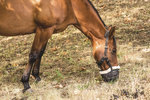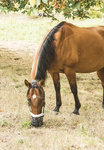

RIDGEFIELD – Many horse owners are familiar with the spring peak in cases of laminitis, sometimes called “founder.”
Laminitis is a disabling and possibly fatal disease of the horse’s hoof which many associate with the rapid growth of high-sugar grasses in the spring. Fall, with its dry pastures and brown grass, is a season most people don’t associate with laminitis. But, what many don’t realize is that the autumn brings higher rates of the disease as well, particularly for horses which are at already at risk.
Dr. Meg Brinton, owner of Ridgefield Equine in Ridgefield, says “We definitely see as many fall cases of laminitis as in the spring, if not more.” The greatest hazard of fall laminitis, Dr. Brinton says, is that it creeps up on horse owners when it’s not expected.
In laminitis, the connecting fibers between the hoof wall and bone become inflamed and fail. Without proper support, the horse’s weight drives the bone down into the hoof capsule. Veins and arteries are sheared and crushed, and the blood delivery system to the coronet and sole is damaged. This results in constant foot pain and lameness for the horse.
Severe damage to the hoof can occur within a few hours. The severity and extent of this initial damage is the single most important factor shaping the long-term outcome. According to Dr. Brinton, laminitis is usually manageable if it’s caught early, but some cases become severe very quickly.
Recent research points to two likely culprits for this fall spike. The first is cooler nighttime temperatures, which cause higher levels of non-structural carbohydrates (NSC) in pasture grasses. And secondly, all horses secrete more adrenocorticotropic hormone (ACTH) as days get shorter and temperatures drop. Both of these lead to elevated insulin levels, a prime cause of laminitis.
As many as 90 percent of laminitis cases are a result of an underlying hormonal condition such as Cushing’s disease (PPID) or Equine Metabolic Syndrome, the equine equivalent of diabetes. Seasonal Rise is the term now used to describe the fall rise in ACTH and resulting insulin and glucose fluctuations in horses with PPID. Before a Seasonal Rise was identified, fall laminitis was often blamed on high sugar and fructan in grasses. But many horses exhibit the same seasonal patterns of laminitis between August and November without access to grass and without any change in their low sugar and starch diet.
Especially at risk are horses who easily become obese, such as ponies and “easy keepers,” which may reflect metabolic problems. Also at risk are horses who have suffered from laminitis in the spring.
Laminitis can be avoided by keeping the horse active and at a healthy weight, maintaining steady or no grain rations, limiting access to grass, and using a grazing muzzle for prolonged turnout. Dr. Brinton advises testing the sugar levels in hay, and soaking hay for an hour before feeding, which reduces sugar levels by 30 percent.
Checking on a horse daily is the most important preventive measure, so changes can be caught early. Several simple tests can assess whether a horse is experiencing hoof changes. Walk him on hard ground such as concrete. Does the stride shorten, or does he walk gingerly? Turn him in a tight circle – is he reluctant to turn or stiff behind? Does he lie down more than usual?
An unusual stance, with front legs stretched out, is also a warning sign. Check the digital pulses of the hoof. A strong pulse at back of horse’s fetlock or abnormally warm hoof wall is a sign of inflammation.
Assess the horse’s body condition for regional fat pads, such as a cresty neck, bulges in hollows above the eyes, an enlarged sheath, and fat above the tail. Hardening of the neck crest or an increase in any of these fat deposits can indicate imminent laminitis.
Over time there may be characteristic changes in the growth pattern of the feet. Heels grow faster than toes, growth rings look curved instead of symmetrical, and a ridged hoof wall is marked with raised rings.
Dr. Brinton emphasizes immediately removing the horse from grass and confining him to an area with deep supportive bedding such as sand or sawdust. The horse will also experience relief from cushioning the feet with boots or pads, and cold therapy such as a cold water bath to the feet to reduce inflammation and pain. Laminitis is an emergency, and warrants a call to the veterinarian.